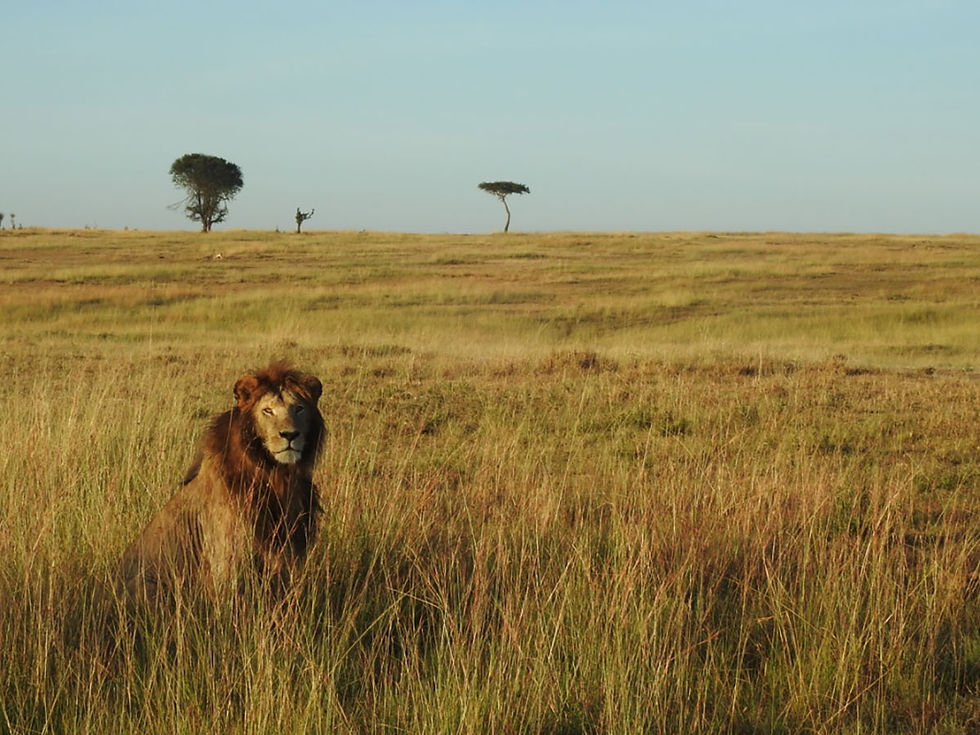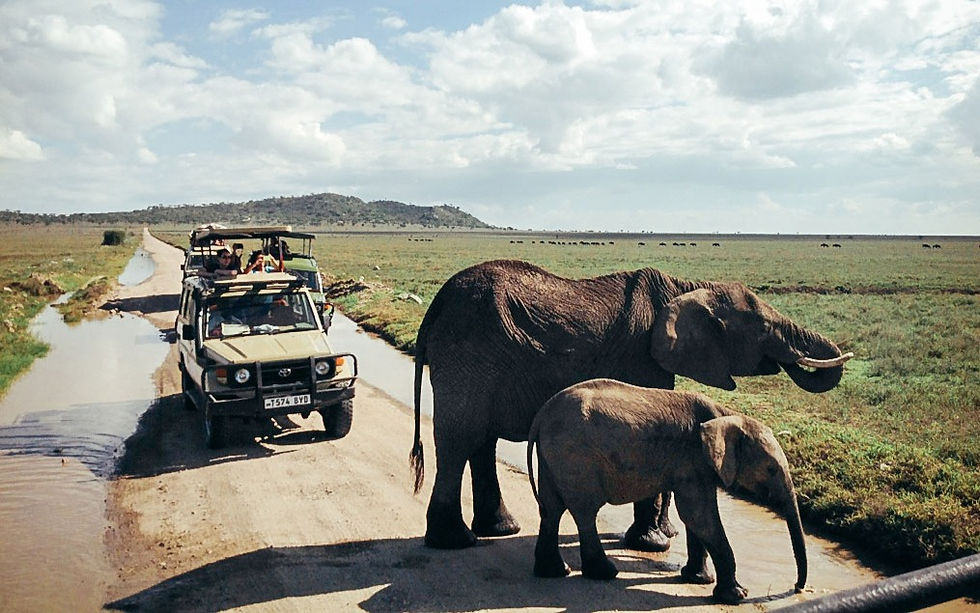Who are the Big Five Safari Animals? Spotting Africa’s Most-wanted
- Catherine Evans
- Mar 7, 2023
- 6 min read
Updated: Nov 18, 2024

Out here in the savannahs of East Africa, the trip planners at Penwell have seen myriad clever lists declared, enticing safari-goers to search every corner of the continent in the name of crossing creatures off their checklists.
The “shy five,” the “Samburu special five,” the “impossible five,” and even the “ugly five” have been used to group game drive wildlife sightings—but there’s no topping the classic granddaddy of them all: the “big five.” Throughout this article, we’ll dive into each of the big five animals you can find while out on one of our Game drives
Running the gamut from lumbering land giants to magnificent felines, the big five refers to the wild beasts considered most dangerous by big-game hunters of yesteryear: the lion, the leopard, the rhinoceros, the elephant, and the Cape buffalo.
With most modern adventurers now opting to sling cameras over their shoulders instead of carbines, the members of the big five are kept alive and well. Let’s take a closer look at the cast of characters that we’re chasing after in our pursuit of Africa’s big five.

1. Lion
Perhaps Africa’s most iconic safari animal, the majestic lion is often at the top of everyone’s big five checklist. Widely known as the “king of the jungle,” the mighty lion is far more likely to be found lording over the expansive grasslands of East Africa’s savannahs than hidden in the leafy foliage of the rainforest—and despite having the lowest continental population of the five, it is one of the most reliable sightings on a game drive.
In Kenya and Tanzania, the Serengeti ecosystem and surrounding national parks—Amboseli, Tsavo, Mara—are your likeliest wild lion locales, together hosting most of the estimated 20,000 lions in Africa. On the crater floor of neighboring Ngorongoro, it’s not uncommon to catch ferocious lionesses on the hunt—or to witness the aftermath: a pride of lions jockeying for position around a felled zebra, the maned males protecting their hoard from the hordes of hyenas circling around.

Lions lying around in the Tanzania plains
Though lion prides have earned a reputation for being fiercely defensive of their territory against other lions, they are nonetheless a safe (though unquestionably hair-raising) sight for safari-goers. At the northern tip of the system, parts of the Maasai Mara even allow for walking safaris through the proverbial lion’s den—just don’t expect any nuzzles from these big cats.

2. Wild Spotted Leopard
As Kipling’s story goes, once the leopard got its spots, it became all the more difficult to spot—and the smaller of the big cats remains to this day one of the most elusive of the big five. Perfectly camouflaged in its rosette-riddled golden coat (some super-rare members go all black!), the leopard’s nocturnal lifestyle, solitary nature, and preference for hiding away in trees make it a lucky sight for searching safari adventurers.
Riverine environments are the most reliable places to catch a glimpse of the African leopard in the wild. Where rivers run through savannahs, acacia trees and bushes crowd the shores, making up the hermetic habitat leopards love most and are best suited to. Astonishing leapers, excellent swimmers, and fast on their feet, leopards target their stealthy strikes on everything from impalas to insects—hauling heavier hunts up into the tree branches for mealtime.

Wild leopard spotting its prey from a tree in Kenya
If you’re driving at dusk through the Serengeti’s Seronera Valley, keep your eyes peeled for the slinky outline of a leopard near the sausage-fruited Kigelia trees, or peeking out from the bluff of a stony kopje. Further south in Tanzania, leopards in remote Ruaha have been known to hunt raptor-like, straight from the treetops. Across the border in Kenya, Tsavo West is renowned for its leopard population. Your best bet, however, may lie in the heart of Kenya, at Samburu National Park, where the otherwise scaredy cats are rather used to vehicles, making game drives both more successful and less intrusive. This is just one of the safari secrets we’ve learned after experiencing the big five safari in Kenya over the years.

3. White Rhinoceros
The subject of intense conservation efforts, African rhinos in Kenya and Tanzania are largely limited to two subspecies in the wild: the rare eastern black rhinocerosand the southern white rhinoceros Though the white rhinos are bigger in all ways by a few degrees, the eastern black rhinoceroses are no small fry, typically weighing in at over 3,000 pounds and occupying the space of a small jeep—both species sport impressively distinctive horns.
These horns are used for a variety of purposes, from rooting around in the dirt for food and water to battling it out with rival rhinos for stomping grounds and breeding partners. Despite such armaments and an almost impenetrably thick hide, rhinos are easily threatened and carry a reputation for a volatile temperament—respectful distances keep horned heads cool, and are the best precaution for admiring these bulky behemoths. All that considered, the aggressive bruisers are just herbaceous browsers, choosing to snack on woody branches, leaves, and fruit.

An extremely rare sighting of a black rhino in Kenya
Small in number, spread out, and only loosely social, rhinos can be a challenging goal to check off your big five list—but this only makes knowing where to go all the more important. In Kenya, conservancies like Ol’ Pejeta (where two northern white rhinos famously survive in captivity) and Lewa, both in the shadow of Mount Kenya, are superb grassland havens for dozens of protected rhinos. Some of the rarest big five safari animals can be found in these grasslands, so this is something you certainly want to include on your expedition!
A little further west in Lake Nakuru National Park, you can find reintroduced wild rhinos nosing around the floodplains of the soda lake, making friends with the flocks of flamingos. For a truly epic experience, a game drive down the ridge wall at Tanzania’s Ngorongoro Crater is hard to beat, and you might find majestic black rhinos roaming free across the sprawling wetlands on the crater floor.

4. Elephant
Standing over ten feet tall with ears almost as wide across, endowed with two prominent ivory tusks, and possessed of a six-foot-long prehensile nose, few creatures on Earth are as singularly recognizable as its largest land animal: the venerable African bush elephant. Popularly renowned for their tenacious memory, African elephants are furthermore quite intelligent—displaying complex social behavior and emotion, problem-solving abilities, and even a sense of humor.
The biggest of the big five has faced many hardships over the past century, but has retained hold on a number of habitats spread across the middle of the African landmass, relying on its intellect, raw strength, and tough skin to adapt to a variety of environments. Elephants travel in tight-knit, matriarchal herds sometimes numbering to 100 individuals, cooperating to find sustenance and protect their families and territory—often digging deep into the dirt with their tusks or uprooting entire trees with their trunks in the process.
On a few of our trips, we did notice elephants losing their tusks, so we decided to create a blog article on this topic if you’d like to check that out as well.

No “Elephant Crossing” signs to be found on this Tanzania safari tour!
To see pachyderms aplenty, head to Tanzania’s Tarangire National Park, where the wildlife density rivals the Serengeti and thousands of elephants roam by the river. Farther out and much wilder, Katavi hosts even more elephants in a rugged, old-school safari setting. For a more modern twist—say, a selfie with hundreds of herded elephants and Mount Kilimanjaro in the background—check out Kenya’s second most-visited park, Amboseli.

5. Cape Buffalo
Compared to the claws and gargantuan stature of its other partners on the big five safari animal list, you might consider the bull-like Cape buffalo as one of the milder members of the pack—but you’d be making a big mistake. With a temper that makes lions tremble, connected horns that hook harder than rhinos, and a vengeful memory that makes elephants look forgiving, nobody but nobody crosses the Cape buffalo.
But if you’re cool, they’re cool—either way, they’ll remember your face for years, so it pays to be good to the gang. Despite the scary reputation, Cape buffalos are noted for their generally kind demeanor with other members of their herd—even displaying uncommonly altruistic behavior and a curious form of group voting. Fighting among members is rare but serious, with good-natured roughhousing and sparring between males a common sight.
Waders of swampy wetlands and voracious grazers of grasslands, Cape buffalos are found in the watery and wide places in east Africa—and the best spots to see them are the classic large parks. Kenya’s Maasai Mara, with its abundant grasses and winding Mara River, is home to thousands of the temperamental ungulates. Herds are also numerous in Ngorongoro, where game drives can encounter them splashing in Gorigor swamp by Lake Magadi, or getting fat and happy on the crater floor grass.

Want to see the Big Five in real life?
That’s our wrap-up for the classic big five safari animals! Think you’re ready to tie these characters, and maybe some others into your tales? Get in touch with us at Penwell, and let’s write your safari story together.





Comments